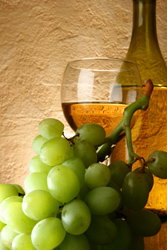Uncorking the functional food potential of wine
The presence of polyphenolic compounds in wine affect the colour, taste and 'mouthfeel' of a wine. The drying effect of red wine for example is the effect of a glut of tannins. The mouth feels dehydrated even though the salivary glands are still operating normally. In an attempt to produce the perfect bottle of wine for a variety of markets, the EU project MAXFUN researched into the chemical analysis of wine and the associated enzyme-linked extraction processes. As the target chemicals are often present in the skin of the fruit, fermentation with the peels as in red wine can yield more of the taste-linked polyphenols in the product. Project partners at the University of Wageningen in the Netherlands focused on extraction methods and treatments. The berries blackcurrant and bilberry were tested for their predisposition to produce polyphenolic compounds and other compounds that would elevate the juice and wine to the status of functional foods. As a first step, analysis of the flash release treatment proved it produced phenolic compounds in larger amounts and at a faster rate. Trials regarding storage, being an important aspect of final wine quality, revealed that the chemistry of the wine had not changed with respect to tannins but that anthocyanins and flavonols decreased dramatically. Gamma linoleic acid, acclaimed benefits of which include reduction of atherosclerosis and rheumatoid arthiritis was found to be in high concentration in blackcurrant. Bilberries had a high yield of polyunsaturated fatty acids generally and tocotrienols, members of the vitamin E group. The cutin concentration, insoluble fibre with a potential role in prevention of carcinogenesis was also analysed. Most of the cutin was found to be in non-ester linked polymers. Consequently, more than 90% was resistant to ester-degrading depolymerisation in the berries. In contrast, 70% of apple cutin yielded monomers using this extraction method. The data from this research highlights the need for production methods to be tailored to fit the biochemical composition of the fruit behind the wine. Further research may not only yield a very good bottle of wine but one that is fortified naturally for its health-promoting qualities.



